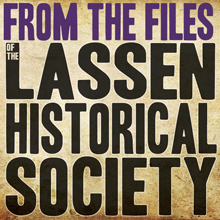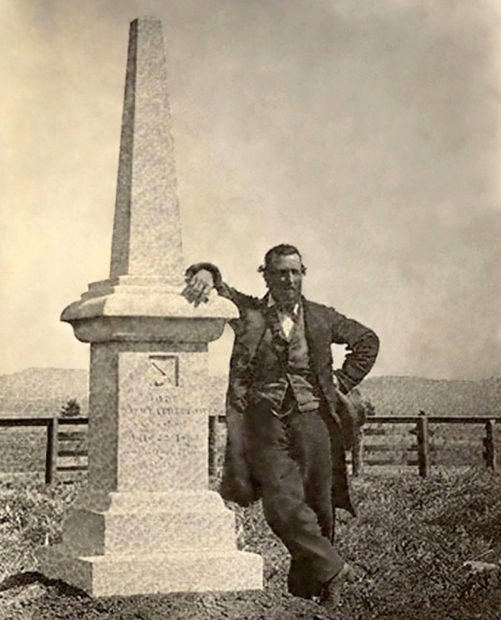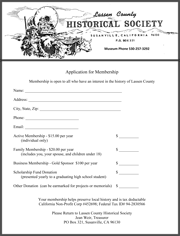

by Susan Couso
For many years after the town of Susanville was founded, Weatherlow Street was the eastern limit of the small settlement. One would think that the street was named for some famous general or highly ranked politician, but William Weatherlow had little acclaim except for a short time in a small area of the state.
Weatherlow was born in Ohio in 1813. His parents, John and Lola Weatherlow married in 1802 when John was 16 years old, and Lola was only twelve. William was the youngest of their six children.
William Weatherlow married Mary Sayles, and they had two children; a son, Francis, who died very young, and a daughter, Lola Caroline, who was 16 years old when she married Joseph Smith Rathburn. Lola had five children and was only 26 years old when she died in December of 1863, just seven months before her father’s death.
The lure of the West had brought Weatherlow to California. He joined John C. Fremont’s party which was assigned by the U.S. Government to explore the western part of the country and protect the settlers when needed.
In 1846, part of Fremont’s group arrived in Shasta City. Captain Weatherlow may have left the Fremont party here, for he was still in the Shasta City area when Isaac Roop arrived in 1850. Roop and Weatherlow became friends. Weatherlow settled in Humbolt County for a time, but then decided to try a new venture with Roop.
Weatherlow came to Honey Lake Valley in May of 1854 and helped his friend, Isaac Roop, build Roop’s cabin. He and Isaac spent the winter of 1855-6 in the cabin, along with Isaac’s brother, Ephriam and William McNaull. By the end of 1856, Weatherlow had built his own cabin nearby, and by March of 1857, the Roop and Weatherlow cabins were the only buildings in what was to become Susanville.
Weatherlow had several land claims in the area, including the abandoned claim of Moses Mason, which was connected to Roop’s northwest corner, where Susanville Ranch Park is now located. He also claimed other parcels of land including some along the Susan River.
In 1856, Weatherlow worked with Chief Winnemucca to form the Reciprocal Treaty to reduce tensions among local citizens. The treaty held great hope, but differences between the sides continued.
A venture in 1859 took Weatherlow into the Black Rock Desert to prospect for silver. Peter Lassen left two days later with his group, and they were to ‘meet up’ out in the desert. Before they joined together in their search for silver, Lassen was murdered. The Weatherlow party was close by but heard nothing of the incident.
In November of 1861, it was supposed that the Honey Lake Valley was in the newly formed Nevada Territory. Lake County, Nevada Territory was created, and William Weatherlow, William Hill Naileigh and Daniel Murray were appointed to organize the new county. Once the true location of the valley was determined by the state surveys in 1863-64, Lake County faded away.
Captain William Weatherlow and his compatriots filled a need for law enforcement in an area that was basically left to its own devices. He has been credited with being the Captain of the Honey Lake Rangers, and also the Plumas Rangers.
The Honey Lake Rangers were a loosely organized group which tried to quell any problems with the local Native inhabitants. Shortly after Weatherlow’s death, in September of 1864, they were officially mustered into the service of the State of California.
Weatherlow was involved in our local history from the beginning and had a hand in the creation of the Nataqua Territory, the Sagebrush War, and the creation of Lassen County. He was a good friend to Isaac Roop and reportedly died of pneumonia in Isaac’s house on July 22, 1864.
The life of Weatherlow was over just a couple of weeks before his 51st birthday and a little more than three months after Lassen County was created. But it took another year to settle his affairs. Weatherlow had been a rather ‘well off’ member of the community. He owned land and property in Lassen County and also in Nevada. His brother, Samuel came to Susanville from New York to get things in order.
There was no will, so Weatherlow’s estate went to probate. As the legal matters were being settled, bills began to pour in with claims to the estate. At least eight doctors sent unpaid bills claiming that they had cared for Weatherlow during his illness, including Dr. Z. N. Spalding who charged $10 for one visit (that’s $193.22 in today’s economy). Dr. R. F. Moody sent a bill for $2.25 ($43.48) for drugs, Dr. Charles Fitch charged $48 ($927.48) for “Eight night’s attendance”, Dr. J. W. Howe claimed $75 ($1449.19) for “medical services”, Dr. Byron Gray spent four days with Weatherlow and charged $25 ($483.06) and Dr. H. Sain charged a mere $3.00 ($57.97) for “taking care in last sickness.” Clearly, Weatherlow had been very sick.
John Thoroughman was building a house for Weatherlow and sent a bill for the work and supplies. His claim for $45 ($869.51) seems very reasonable. William Hill Naileigh charged an additional $15 ($289.84) for the chimney.
Dying can be expensive. There were administrative fees, attorney fees, appraisal fees, even a bill for $11.35 ($219.86) for the school tax.
Local merchants sent their unpaid bills too, and there seemed to be quite a bit of brandy and whiskey sold.
George Heap sent a bill for 3 bottles of brandy, 2 lbs. of candles, and then added $3 ($58.11) for grave digging. But W.H. Crane also charged $15 ($290.57) to dig the grave, shave, wash and dress the deceased, at which point George Heap had to return his $3 grave digging fee. Miller & Kingsley charged $27.13 ($525.54) for ‘coffin fixings’ but W.H. Crane charged $60 ($1,162.27) to finish the coffin.

M. F. Thompson sent a bill for William Weatherlow’s large stone monument for $140.00 ($2,705), which seems a pretty good price. But interestingly the estate paid $179.50 in ‘legal tender’. It seems that gold coin was much preferred. The Civil war had caused paper money to be looked upon with suspicion.
The claims against the estate had finally slowed down as anyone who could think of anything had made their case. After almost a year, Samuel Weatherlow was ready to end the business and get back to his normal life. His inheritance amounted to a couple of thousand dollars in 1865, a pretty nice inheritance, but before he was allowed to receive anything, Samuel Weatherlow had to swear and sign allegiance to the United States of America.
Finally, on July 10, 1865 it was settled. William Weatherlow’s life was over, and his possessions had been dispersed properly according to the courts.
His grave in the Susanville Cemetery has held a prominent place just west of his friend Isaac for nearly 160 years now.

If you are a fan of our weekly history stories you should join the Lassen County Historical Society! It’s a fun way to be a part of our county’s rich history. When you sign up, you’ll receive regular Historical Society newsletters with interesting stories and information. Membership is open to anyone with an interest in area history.
Through your membership you help preserve local history. You can download a membership application by clicking here.






